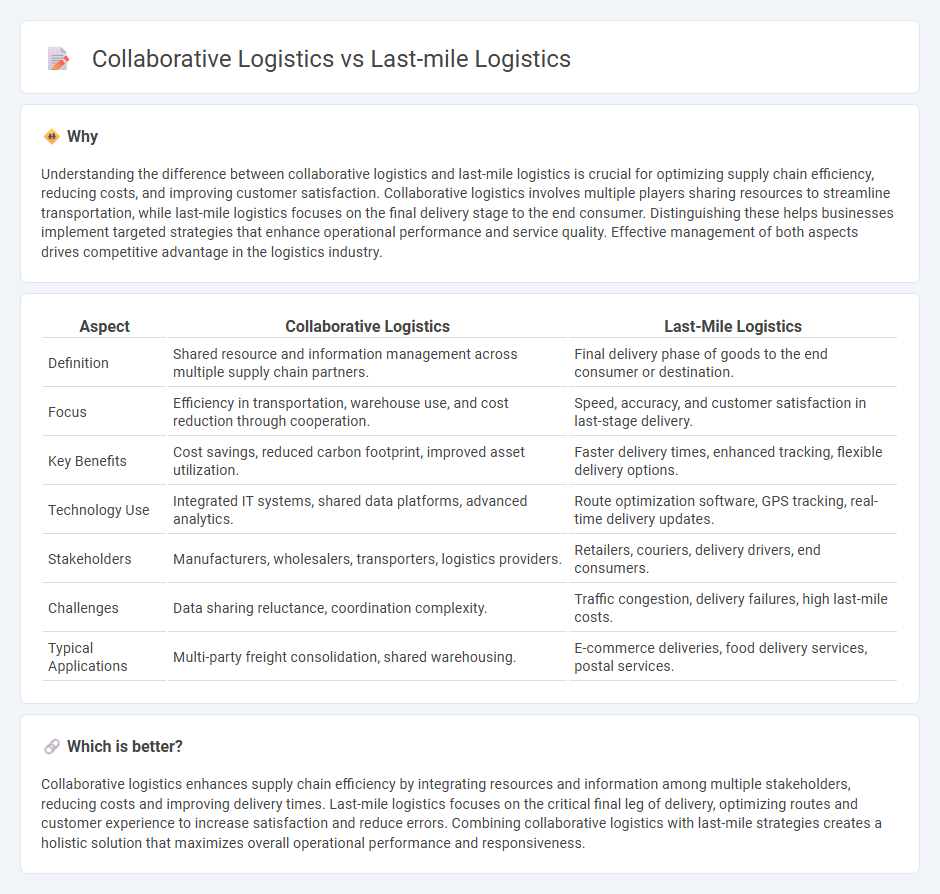
Collaborative logistics focuses on sharing resources, information, and infrastructure among multiple stakeholders to optimize overall supply chain efficiency and reduce costs. Last-mile logistics centers on the final delivery stage, ensuring timely and accurate distribution of goods directly to the end customer, often facing challenges like urban congestion and delivery time windows. Explore how these distinct logistics strategies impact modern supply chains and customer satisfaction.
Why it is important
Understanding the difference between collaborative logistics and last-mile logistics is crucial for optimizing supply chain efficiency, reducing costs, and improving customer satisfaction. Collaborative logistics involves multiple players sharing resources to streamline transportation, while last-mile logistics focuses on the final delivery stage to the end consumer. Distinguishing these helps businesses implement targeted strategies that enhance operational performance and service quality. Effective management of both aspects drives competitive advantage in the logistics industry.
Comparison Table
| Aspect | Collaborative Logistics | Last-Mile Logistics |
|---|---|---|
| Definition | Shared resource and information management across multiple supply chain partners. | Final delivery phase of goods to the end consumer or destination. |
| Focus | Efficiency in transportation, warehouse use, and cost reduction through cooperation. | Speed, accuracy, and customer satisfaction in last-stage delivery. |
| Key Benefits | Cost savings, reduced carbon footprint, improved asset utilization. | Faster delivery times, enhanced tracking, flexible delivery options. |
| Technology Use | Integrated IT systems, shared data platforms, advanced analytics. | Route optimization software, GPS tracking, real-time delivery updates. |
| Stakeholders | Manufacturers, wholesalers, transporters, logistics providers. | Retailers, couriers, delivery drivers, end consumers. |
| Challenges | Data sharing reluctance, coordination complexity. | Traffic congestion, delivery failures, high last-mile costs. |
| Typical Applications | Multi-party freight consolidation, shared warehousing. | E-commerce deliveries, food delivery services, postal services. |
Which is better?
Collaborative logistics enhances supply chain efficiency by integrating resources and information among multiple stakeholders, reducing costs and improving delivery times. Last-mile logistics focuses on the critical final leg of delivery, optimizing routes and customer experience to increase satisfaction and reduce errors. Combining collaborative logistics with last-mile strategies creates a holistic solution that maximizes overall operational performance and responsiveness.
Connection
Collaborative logistics enhances last-mile logistics by integrating multiple stakeholders to share resources, routes, and information, thereby reducing costs and improving delivery efficiency. The synergy between collaborative platforms and last-mile delivery networks optimizes package distribution in urban areas, mitigating traffic congestion and environmental impact. Data-driven collaboration enables real-time tracking and dynamic route planning, which are critical for meeting customer expectations in fast-paced e-commerce markets.
Key Terms
**Last-mile logistics:**
Last-mile logistics involves the final phase of the supply chain, focusing on delivering goods directly to the end consumer with an emphasis on speed, efficiency, and cost-effectiveness. Key challenges include managing urban congestion, optimizing delivery routes, and utilizing advanced technologies like GPS tracking and real-time data analytics to improve delivery accuracy and reduce operational costs. Explore comprehensive strategies and innovations in last-mile logistics to enhance customer satisfaction and streamline delivery processes.
Delivery optimization
Last-mile logistics centers on optimizing delivery routes and reducing transit times to enhance customer satisfaction through faster, cost-effective shipping. Collaborative logistics leverages shared resources and data among multiple stakeholders to improve delivery efficiency, reduce costs, and minimize environmental impact. Explore how integrating these approaches can revolutionize delivery optimization and drive operational success.
Route planning
Last-mile logistics prioritizes optimizing individual delivery routes to reduce transit times and improve customer satisfaction, employing technologies like GPS tracking and real-time traffic data. Collaborative logistics enhances route planning by integrating resources from multiple carriers, enabling shared delivery networks that minimize costs and environmental impact. Explore how route planning innovations in both models can drive efficiency and sustainability in supply chain management.
Source and External Links
Closing the logistics loop with last-mile delivery - Last-mile delivery is the final step in the supply chain where goods move from a local distribution center to the end customer, crucial for fast, precise deliveries especially in e-commerce, and accounting for 53% of total shipping costs which businesses strive to optimize.
What is a Last Mile? Complete Guide to Last Mile Delivery ... - Last-mile delivery connects brands to consumers with the final delivery, and automation like route planning and predictive analytics reduce costs and errors by optimizing routes and improving resource allocation.
What is Last Mile Logistics? - Last-mile logistics involves managing and optimizing the final leg of a product's journey from warehouse or distribution center to customer doorstep, addressing complexities like choosing providers, routing, on-time delivery, and cost reduction.
 dowidth.com
dowidth.com